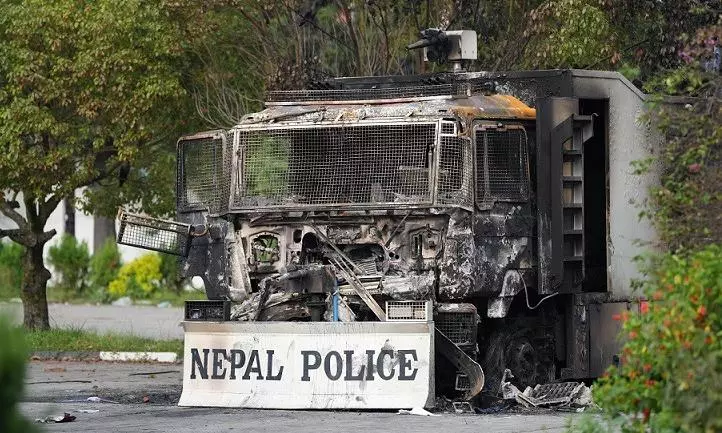
- Home
- India
- World
- Premium
- THE FEDERAL SPECIAL
- Analysis
- States
- Perspective
- Videos
- Sports
- Education
- Entertainment
- Elections
- Features
- Health
- Business
- Series
- In memoriam: Sheikh Mujibur Rahman
- Bishnoi's Men
- NEET TANGLE
- Economy Series
- Earth Day
- Kashmir’s Frozen Turbulence
- India@75
- The legend of Ramjanmabhoomi
- Liberalisation@30
- How to tame a dragon
- Celebrating biodiversity
- Farm Matters
- 50 days of solitude
- Bringing Migrants Home
- Budget 2020
- Jharkhand Votes
- The Federal Investigates
- The Federal Impact
- Vanishing Sand
- Gandhi @ 150
- Andhra Today
- Field report
- Operation Gulmarg
- Pandemic @1 Mn in India
- The Federal Year-End
- The Zero Year
- Science
- Brand studio
- Newsletter
- Elections 2024
- Events
- Home
- IndiaIndia
- World
- Analysis
- StatesStates
- PerspectivePerspective
- VideosVideos
- Sports
- Education
- Entertainment
- ElectionsElections
- Features
- Health
- BusinessBusiness
- Premium
- Loading...
Premium - Events

Far from a spontaneous outburst, the youth-led uprising reveals deep-rooted economic despair, inequality, and systemic corruption that the Karki govt can't ignore
The Gen-Z movement in Nepal, which erupted on September 8, caused extensive damage to public and private property and tragically resulted in numerous casualties among young people. The immediate political outcome of this unrest was the formation of an interim government under former Supreme Court Chief Justice Sushila Karki.
While the political dimensions of the movement have been widely discussed, the underlying economic factors that drove the youth to such extreme action merit detailed examination.
The protests were not simply spontaneous, they were the cumulative result of systemic economic mismanagement, social inequality, and institutional corruption that have persisted for decades.
Also read: In Nepal, earlier uprisings, social media targeted soft underbelly of rigid state
Long-term issues
Since the monarchy was abolished in 2008, Nepal has experienced 14 successive governments, yet very few have successfully addressed the fundamental economic needs of its citizens.
Public welfare programmes and employment-creation initiatives have consistently fallen short of the population’s requirements. Youth unemployment remains particularly alarming, fluctuating between 19 and 22 per cent. This chronic unemployment has fostered widespread frustration and disillusionment among the country’s younger generation, many of whom see little hope for economic mobility within Nepal.
What pushed Nepal’s youth to the brink?
♦ Chronic youth unemployment at around 20%
♦ Rampant corruption eroding public trust in governance
♦ Wealth inequality widening between elites and poor
♦ Rising cost of living despite low official inflation
♦ Misuse of public funds in major infrastructure projects
♦ Mass labour migration due to lack of local jobs
Corruption has further exacerbated these challenges, eroding confidence in government institutions. In the 2024 global corruption index, Nepal was ranked 107th out of 180 countries, reflecting pervasive weaknesses in institutional accountability.
Also read: Nepal violence: PM Karki gives clean chit to Gen Z protesters, pledges justice
Political leaders have frequently been implicated in various scandals, while the very agencies tasked with combating corruption—including courts, anti-corruption bodies, and state machinery—have themselves often been compromised. Consequently, governance has often devolved into elite power struggles rather than effective public service delivery, leaving ordinary citizens feeling marginalised and powerless.
Haves and have-nots gap
Economic inequality has also contributed to the unrest. Although poverty levels have declined from 25 to 20 per cent over the past decade, wealth remains highly concentrated in the hands of a small elite.
The richest 10 per cent of Nepalese citizens now control nearly 26 times the wealth of the poorest 40 per cent. This imbalance is particularly evident in the lifestyles of children of political elites, often referred to as “nepo kids,” who regularly showcase luxury goods, travel abroad, and display their privileged lives on social media. In contrast, children from less affluent families struggle to access basic education, healthcare, and even daily necessities.
The stark contrast in living standards, amplified by the visibility of social media, has intensified frustration among underprivileged youth and contributed to the social unrest that fuelled the Gen-Z movement.
Labour migration
Labour migration has played a central role in shaping economic grievances. Each year, between 400,000 and 500,000 Nepalese citizens leave the country for work abroad, excluding those migrating to India. In peak years, such as 2024-25, the number of migrants exceeded 700,000, equating to nearly 1,900-2,000 individuals leaving daily.
Watch: 'New Delhi should engage with Kathmandu, but respect Nepal's sovereignty'
Currently, more than five to six million Nepalese youth work in countries such as the UAE, Malaysia, Qatar, Saudi Arabia, Australia, and across Europe, in addition to 3.5 to 8 million employed in India. Social media platforms such as Facebook, Instagram, WhatsApp, YouTube, and X are essential for these migrant workers to maintain communication with families at home.
The government’s abrupt ban on 26 such platforms disrupted these vital connections, intensifying the alienation and frustration of young people already feeling excluded from political and economic decision-making.
How NGOS, INGOs mobilise youth
The widespread mobilisation of youth across Kathmandu Valley and other districts during the protests also points to significant organisational and financial support.
The influence of NGOs (non-governmental organisations) and INGOs (international non-governmental organisations) in Nepal has grown dramatically over the past three-and-a-half decades. In 1990, only 253 NGOs were registered with the Social Welfare Coordination Council in the country, but by 2023, their number had increased to nearly 50,000, while INGOs rose to 230.
Also read: Nepal president’s dissolution of parliament sparks political, legal criticism
Many of these organisations operate with limited transparency and, in some cases, have been accused of functioning as parallel governance structures. Certain NGOs have reportedly received substantial foreign funding to support advocacy and mobilisation initiatives, which may have indirectly contributed to the scale and organisation of the Gen-Z protests.
Rising inflation
Inflation has further compounded the economic pressures on Nepalese households. Official figures report a rate of 4.06 per cent, yet public perception suggests that the cost of living is rising much faster, particularly for essential goods and services.
Rising expenses erode disposable income, disproportionately affecting poorer families and adding to the perception of economic injustice.
Corruption has permeated all levels of government over the past three-and-a-half decades of multiparty democracy. Mismanagement of funds in large-scale infrastructure projects, including the Pokhara and Bhairahawa international airports and the controversial acquisition of six Chinese aircraft, illustrates systemic financial inefficiency.
Watch: Nepal crisis: What’s next after Oli? India–China stakes explained
Fund misuse, high-profile scandals
Provincial and local governments, established under the 2015 constitution, have misused development funds and other public resources. Additionally, the imposition of high taxes and administrative fees by local authorities has further fuelled discontent among ordinary citizens.
A series of high-profile scandals has intensified public distrust in political leadership. Among these are the Lalita Niwas land grab, the Patanjali land deal (2009-2011), the Bhutanese refugee crisis (2023–2024), the wide-body aircraft procurement scandal (2017-2025), the visit visa extortion case (2025), and the Giri Bandhu Tea Estate land scam (2020-2025).
Each case revealed the involvement of influential political leaders and officials in financial irregularities, reinforcing the perception of systemic corruption and governance failure.
Challenge for Karki govt
The Gen-Z movement, therefore, should be understood not as a spontaneous eruption but as the result of accumulated structural and economic frustrations. While the immediate trigger was the sudden restriction on social media platforms, the deeper causes include unemployment, economic inequality, rampant corruption, inflation, and ineffective governance.
The uprising left 72 people dead and over 2,000 injured, underscoring the severe human cost of systemic neglect. The interim government under Sushila Karki faces the dual challenge of restoring public order and addressing the long-standing economic grievances that fuelled the protests.
Also read: The rumbling rage that erupted on Nepal's streets: Deep dive into Gen-Z protests
Thus, the Gen-Z movement in Nepal is a stark illustration of how persistent economic frustration, coupled with social inequality and weak governance, can catalyse mass youth mobilisation. It highlights the urgent need for Nepal’s leadership to implement comprehensive reforms that promote equitable economic growth, curb corruption, enhance employment opportunities, and empower young citizens.
Addressing these structural issues is essential not only to prevent future unrest but also to strengthen Nepal’s democratic institutions and ensure a stable, inclusive, and prosperous society for all its citizens.
(The Federal seeks to present views and opinions from all sides of the spectrum. The information, ideas or opinions in the articles are of the author and do not necessarily reflect the views of The Federal)


